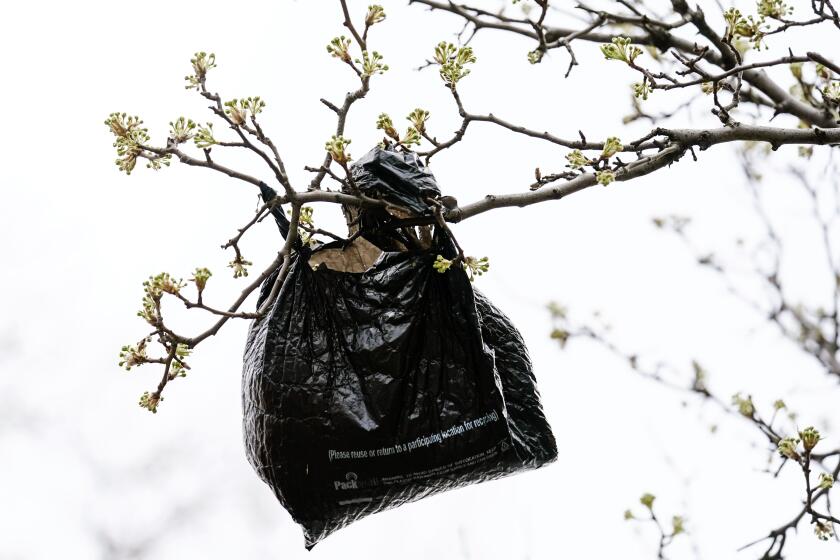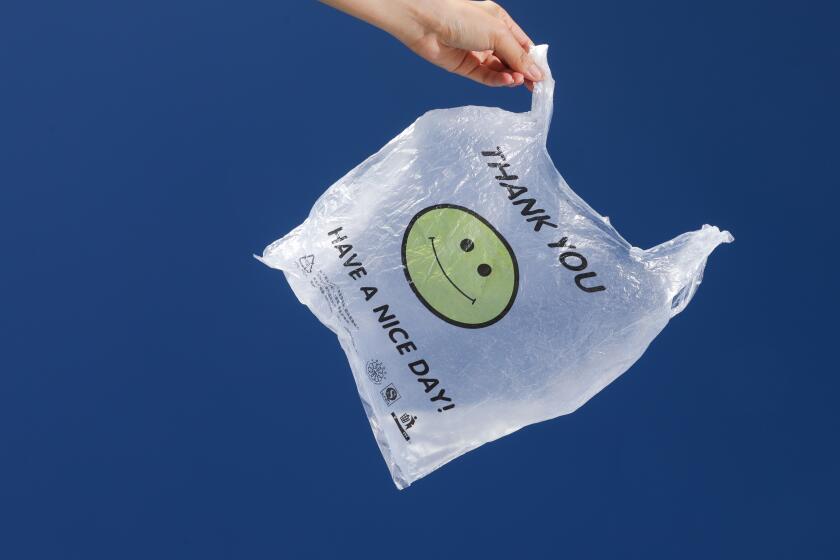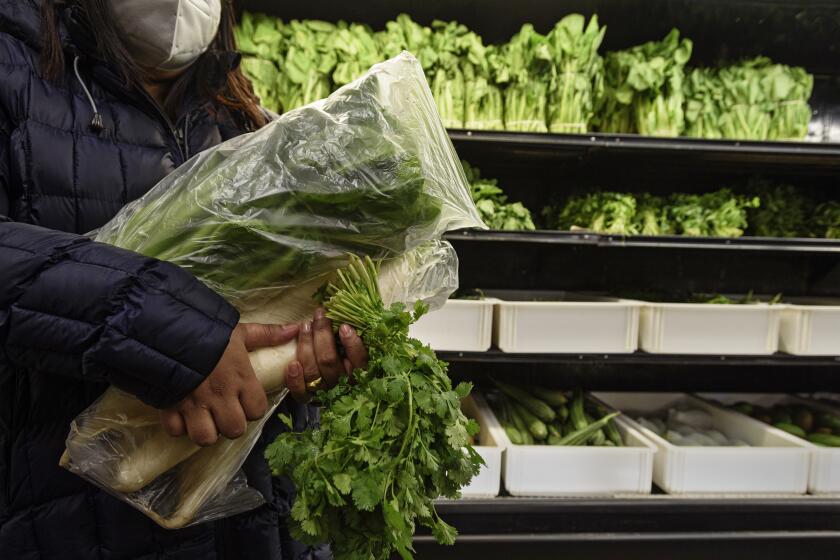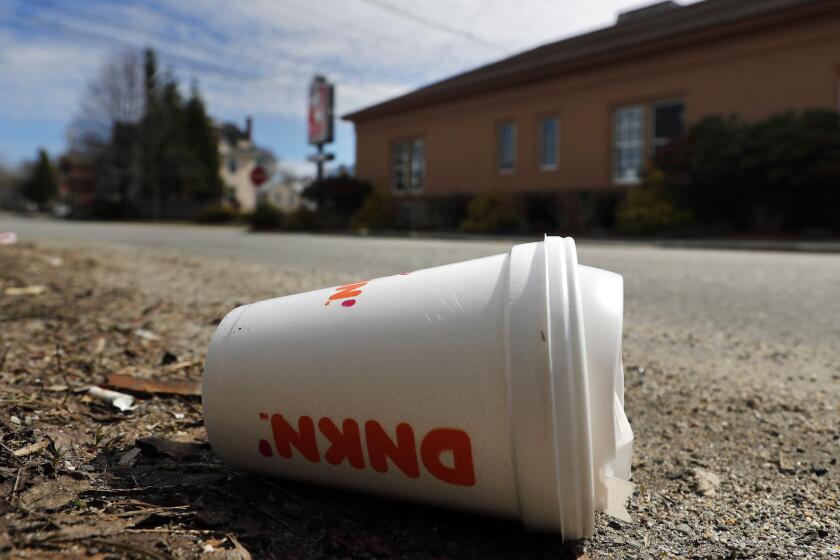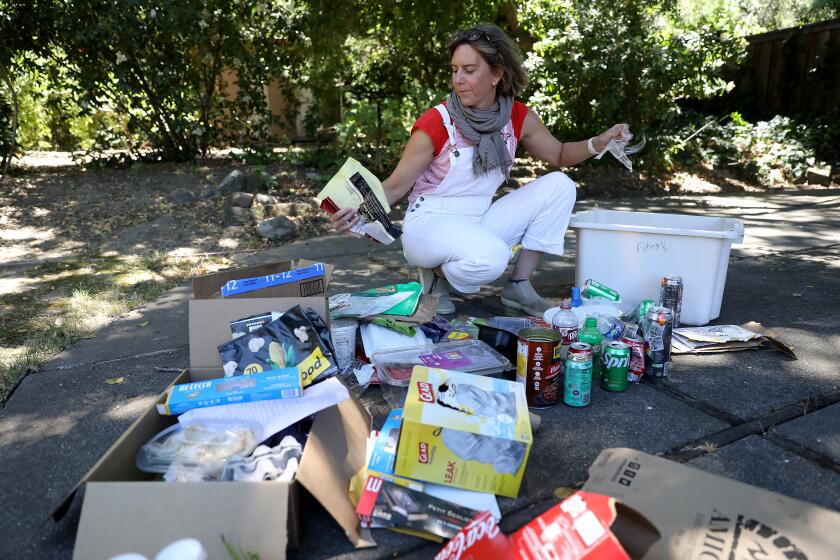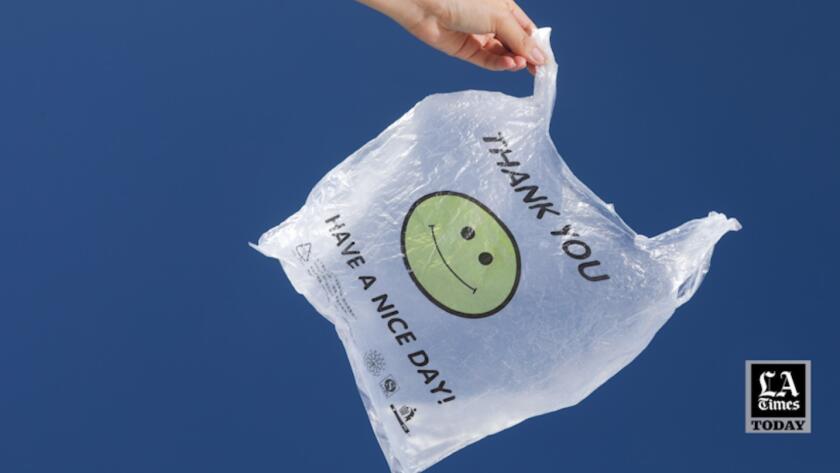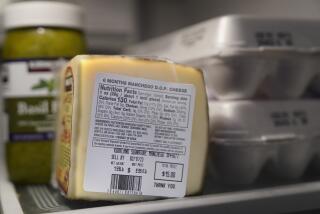
- Share via
Does California have a ban on plastic bags?
The goals of Senate Bill 270, the so-called plastic bag ban, spoke to the “three Rs” of waste reduction: Reduce the number of plastic bags Californians use, reuse the ones they receive, and recycle them once their useful life has ceased (the bags, not the Californians).
The thin plastic bags that used to line every bathroom trash can and litter box in California were and are made of low-density polyethylene, or LDPE. More than 30 billion of those single-use plastic carryout bags used to be distributed across California every year.
California’s 2014 bag ban law focused on grocery stores, which can no longer give you one of those thin plastic bags. But they can sell you a heftier sack made of high-density polyethylene, or HDPE.
It’s not a bad deal for the stores. It’s also not a tax; taxes are paid to the government. Stores buy bags for about 5 cents each, and sell them for at least double that, pocketing the profits. The law also mandated that the HDPE bags “shall be recyclable in the state.” If you look at the bottom of one, you’ll see the cheerful “chasing arrows” logo, the universal indicator that an item can be recycled.
If the Golden State is going to lead the world toward a better, safer future, our political and business leaders — and the rest of us — will have to work harder to rewrite the California narrative. Here’s how we can push the state forward.
So you can put them in your curbside recycling bin, right? Wrong, says the EPA — plastic bags need to go to specialty recycling facilities. Many municipal workers say plastic bags have to be manually removed from the machinery at regular recycling centers, and then they end up in a landfill. What’s more, The Times reached out to municipal and city recycling centers around the state and was unable to find a single one that accepts HDPE bags for recycling. So, is there a solution? Well, you’re supposed to take HDPE bags back to grocery stores and put them in designated bins to be recycled. (More on that process later.)
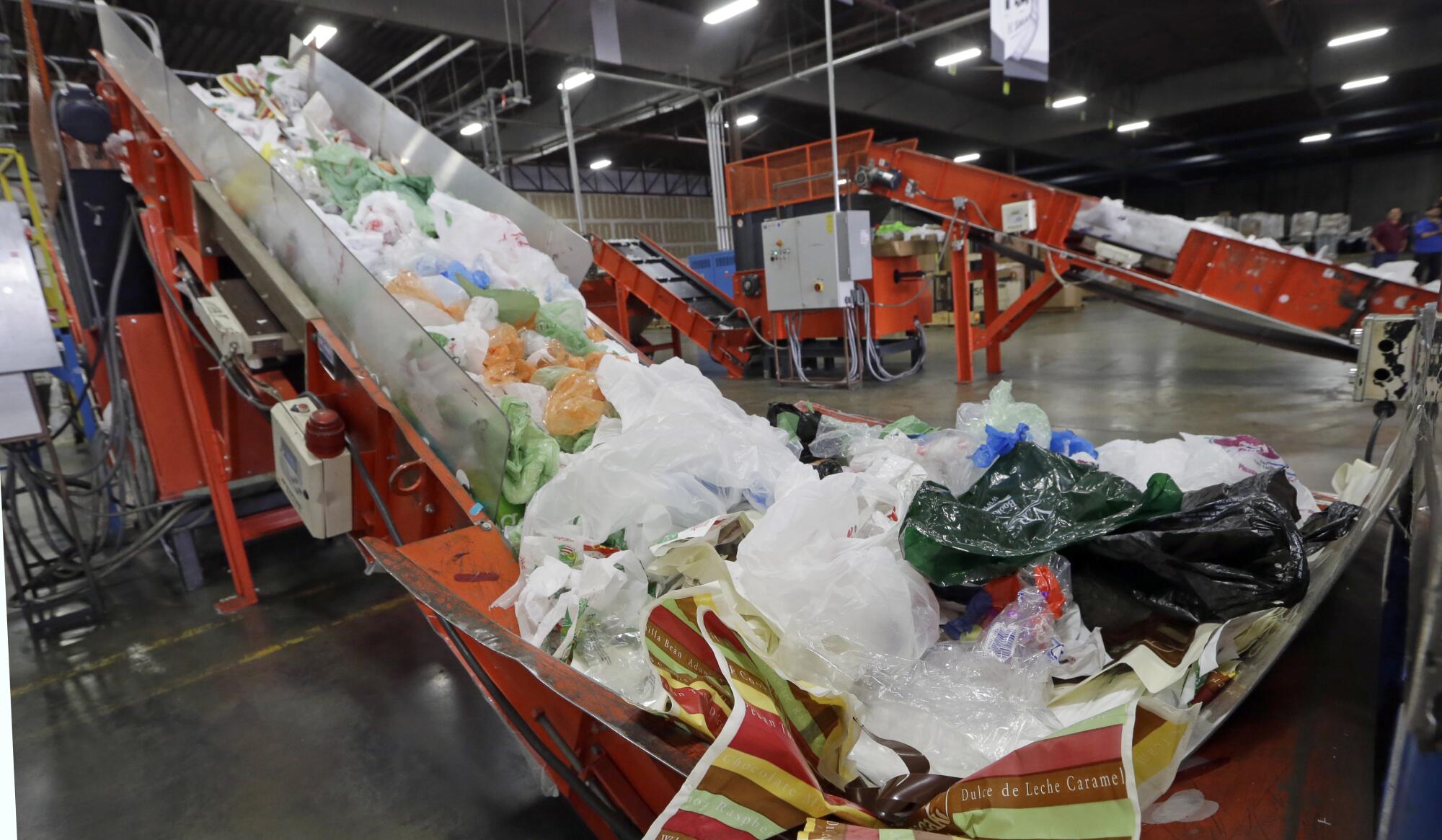
Ron Fong, the president and chief executive of the California Grocers Assn., a trade association that represents grocery stores and grocery store suppliers, said his group’s internal polling showed the majority of large grocery retailers do have contracts for bag take-back bins with recycling companies, though he wasn’t authorized to name those companies.
“The polling that we had was that our grocers took [plastic bag recycling] seriously and have done the responsible thing,” Fong said.
When asked whether any recycling centers in the state have a program for recycling post-consumer HDPE plastic bags, a spokesperson for CalRecycle, the state agency that oversees California waste management and recycling, had this to say:
“Plastic bags aren’t recycled on a large scale in California,” Maria West said in an email, though “some collection programs are accepting bags in case they can find markets.”
Atty. Gen. Rob Bonta is pushing back on the lie that plastic grocery bags used in California are recyclable. Good for him.
The pandemic bag backslide
California was the first state to enact a single-use plastic bag ban, all the way back in 2014. The law faced considerable headwinds, including a multimillion-dollar lobbying effort from plastic bag manufacturers. That lobbying set efforts back two years by forcing a referendum, but voters affirmed SB 270 in the November 2016 election, and the ban on LDPE bags and the system of selling HDPE bags went into effect the next day.
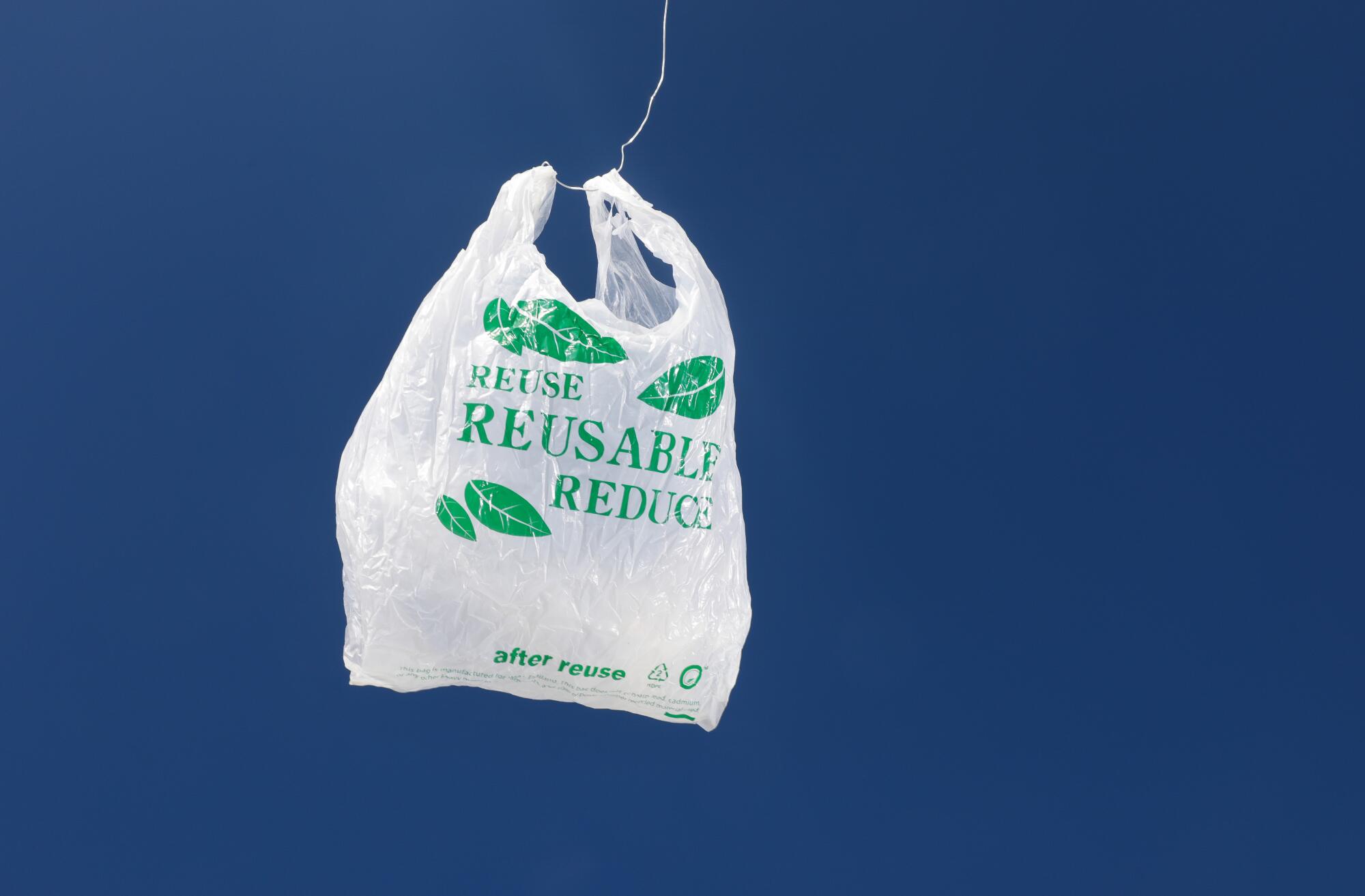
Though plastic bags represent a fraction of plastics produced, they are a unique source of blight, according to Mark Murray, the executive director of environmental group Californians Against Waste. They blow into tree branches, clog sewer drains, wrinkle jellyfish-like in our oceans and tumble across our roads. Because they’re so light, they defy proper waste management, floating off trash cans and sanitation trucks like they’re being raptured by a garbage god.
“You go to any landfill in California and there are these huge fences, 20-foot, 30-foot fences,” Murray said. “Those fences aren’t there to keep you out of the landfill. They’re there to keep the plastic bags in.”
Most likely, you use a single-use plastic bag for as long it takes to get your groceries home. A few minutes. Maybe a few days, if it gets to be a garbage bag. It will spend the rest of its life in a landfill — assuming the landfill can contain it — fragmenting into smaller and smaller pieces of plastic over hundreds of years. Bags became a target for legislation, Murray said, because they were the poster child for everything wrong with the proliferation of unnecessary plastic.
California’s bag ban has been in effect since 2016. But are grocery store customers bringing their reusable bags back to stores? We stood outside to find out.
The law took a big hit in 2020. The plastics industry seized the moment when COVID-19 pandemic lockdowns went into effect. Reusable bags of any kind brought from home were “virus-laden”; they were “petri dishes for bacteria and carriers of harmful pathogens,” industry groups were quoted as saying by the New York Times. Bringing them into stores “puts consumers and workers at risk,” the Plastics Industry Assn. wrote in a letter to the U.S. Department of Health and Human Services.
California Gov. Gavin Newsom suspended the state’s ban on grocery stores providing single-use plastic bags for 60 days amid COVID-19 concerns: The Times reported there were concerns “that clerks may be at risk for exposure to the coronavirus if shoppers are required to supply their own reusable bags to carry their purchases home.”
It is now known that COVID spreads primarily via air. COVID transmission was never linked to reusable bags.
Eventually, the bag charges came back. But reusable bags — the ones you did bring from home — didn’t. Today, most shoppers who get bags for their groceries get all-new HDPE bags every time. (Oh, and have you noticed that most of these “don’t forget your reusable bags” signs have disappeared from grocery stores?)
Are Californians reducing and reusing?
There isn’t much official data about consumer bag usage. But there are other ways to measure the prevalence of plastic bags in post-ban California.
In 2010, volunteers with the California Coastal Cleanup removed 65,736 plastic bags of all kinds from the shoreline, water, watercraft and coastal recreational areas.
Coastal Cleanup Day 2016 was held before the statewide ban was in effect, but between the 2010 and 2016 cleanups, dozens of cities and counties across California had enacted single-use plastic bag bans of their own, including Los Angeles. The effect was noticeable: In 2016, only 24,602 plastic bags were picked up.
But the number of plastic bags volunteers pick up every year has stayed relatively flat since then. In 2022, 26,690 plastic bags were removed on Coastal Cleanup Day.
Two months after passing historic plastics legislation, state lawmakers send a half-dozen more bills to the governor’s desk to reduce waste.
Every few years, CalRecycle does a waste characterization study, in which it analyzes what’s going into landfills to determine the types and amounts of materials we’re throwing away. In 2004, Californians disposed of 147,038 tons of plastic grocery and merchandise bags. Murray of Californians Against Waste extrapolated the data: Back then, the population of California was a little over 35 million people, so that equaled about eight pounds of plastic bags per person.
CalRecycle has repeated the study several times, most recently in 2021, when Californians discarded 231,072 tons of plastic bags. Our 2021 population was around 39 million. That works out to 11 pounds of bags per person. Murray called the numbers “dispiriting.”
So the data support the idea that, broadly, plastic bag bans in our state have decreased plastic bag blight on our shores since 2010, but that the statewide ban hasn’t made much additional impact. And despite the ban, more plastic bags are landing in landfills.
Where do the bags in store drop-off bins go?
When you’re done with HDPE bags, you’re supposed to take them to a specially marked bin inside a store to await transport to a specialized recycling facility. California stores used to be required to keep records describing the collection, transport and recycling of plastic bags. But the law requiring those records was allowed to sunset in 2020. Stores are currently not required to offer take-back bins or report on the destination of the bins’ contents.
A recent ABC News investigation put Apple Airtag trackers inside dozens of these bins around the country, including two Targets and a Walmart in San Diego County. Of the three trackers in San Diego, two landed at landfills. The other never left the store. Out of 46 trackers deployed nationwide, four ended up at facilities that say they recycle plastic bags.

None of this surprised Jan Dell. After a 35-year career as a chemical engineer observing firsthand the global impacts of plastic waste, she launched the Last Beach Cleanup, a nonprofit environmental organization. She deployed 15 trackers of her own in store drop-off bins around Southern California. Eleven went to landfills or waste transfer stations. One went to a trash incinerator. Another last pinged at the Port of Los Angeles, which she said likely means it was headed to Asia. Two more wound up in Mexico, possibly also en route to Asia.
None went to recycling facilities.
The California Statewide Commission on Recycling Markets and Curbside Recycling issued a report in December 2021 with a formal recommendation for retailers and product manufacturers to remove the words “recycle” and “recyclable,” as well as the recycling symbol, from HDPE plastic bags. Dell was a member of the commission when the letter was sent.
California in 2014 enacted the first U.S. ban on single-use plastic shopping bags. Now Atty. Gen. Rob Bonta is investigating whether reusable plastic bags are recyclable as required by law.
Part of it read: “There is not a comprehensive store take-back system in California.”
What does it mean to be recyclable?
An item is recyclable if it can be broken down into its raw materials and those materials can be sold. That an item is capable of being reduced to its base elements does not confer recyclability: There has to be a market for it; it has to be profitable.
It used to be quite profitable to sell our plastic recyclables to China, but that is no longer the case. China once imported 70% of the world’s plastic, including 700,000 tons a year from the United States. In 2017, however, China announced Operation National Sword, which banned the practice.
Since then, there has been no national call in the U.S. to reduce plastic waste or packaging, no public awareness campaigns that the things you could once throw in the recycling bin and trust that they would be recycled are now just on a field trip en route to a garbage heap.
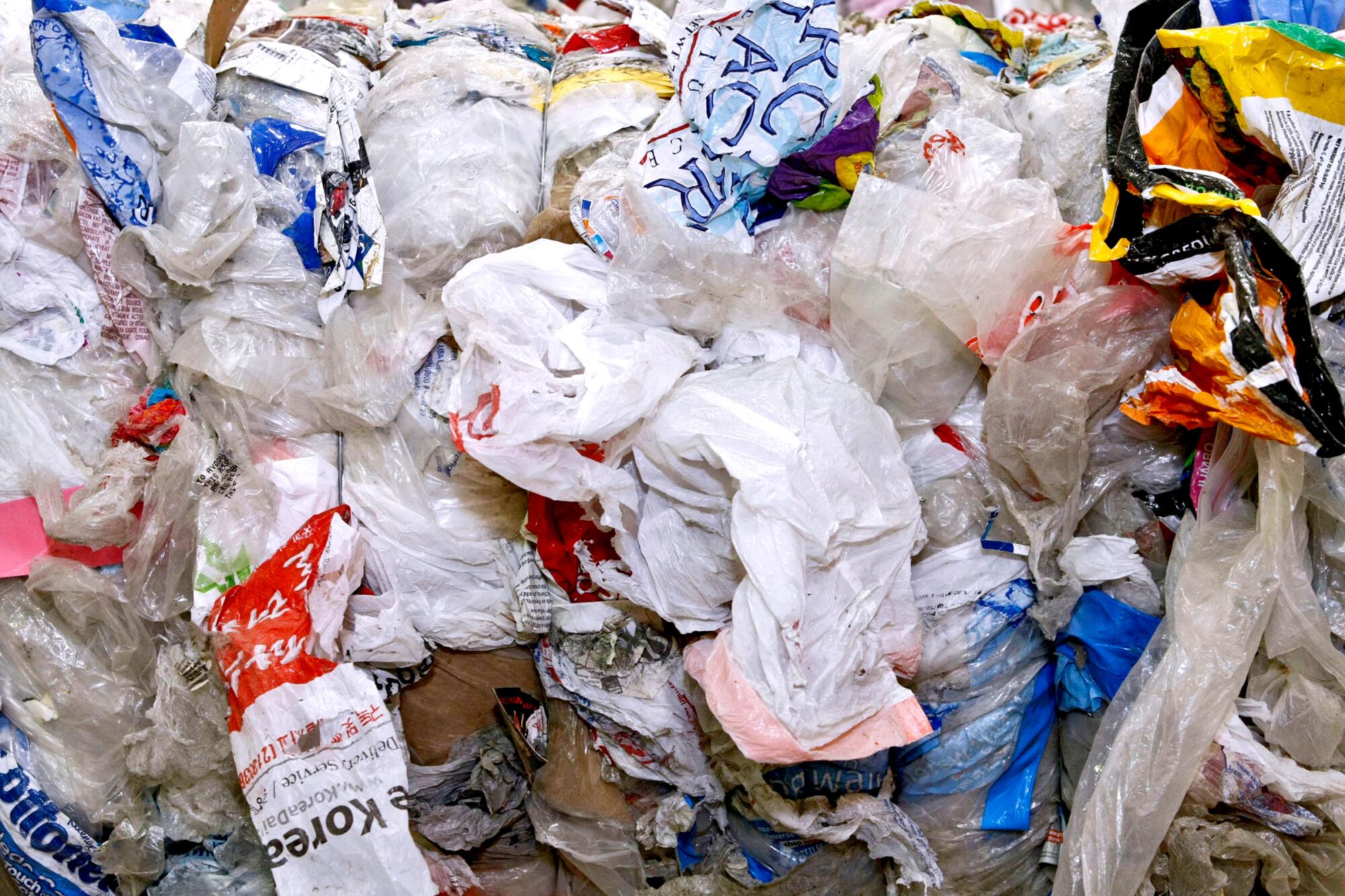
So where’s it all going? If not our landfills, then to other countries — sometimes with the help of criminal trash trafficking rings — which either burn it, put it in their landfills, or dump it in the soil or water.
Recycling centers in the U.S. also suffer from “aspirational recycling,” where people throw things that they think should be recyclable into their recycling bins. Roughly a fifth of what ends up at recycling centers can’t be recycled.
The new ordinance bans the distribution and sale of expanded polystyrene products, which are often colloquially referred to by the trade name Styrofoam.
Used plastic utensils, full plastic water bottles, used tissues — these sorts of items are known as “contaminants in the recycling stream.” The worst offenders: plastic bags. They wind themselves around the idlers and pulleys of the conveyor belts, jam the bed knives in the shredders, get tangled in the shafts of the disc screens and snarl the parallel paddles of the ballistic separators.
If you vacuumed up a plastic bag, you’d probably have to take apart the whole machine to fix it. That’s what happens in recycling centers. The one in Burbank has to clear plastic bags from screens four times every day, on two dedicated 10-minute breaks and again for 30 minutes at lunch and at the end of the day. Phoenix’s city recycling center estimates it loses $1 million a year on bag extraction.
A single-digit number of specialized commercial facilities in California have the capacity to recycle what’s known as polyethylene plastic film, which includes HDPE grocery bags as well as the plastic wrap that keeps products in place on shipping pallets and in agricultural bales. It’s not clear whether any of these facilities currently receive used plastic grocery bags for recycling, or whether they would recycle them if they did.
But it’s still the case that to comply with state law, HDPE plastic bags must be recyclable in the state of California. State Atty. Gen. Rob Bonta said in November that his office was launching an investigation into whether that requirement is being met.
Bonta announced his office was asking six major bag manufacturers — Novolex, Revolution, Papier-Mettler, Inteplast, Advance Polybag and Metro-Polybag — to affirm that their HDPE bags are being recycled in the state.
A representative for the attorney general’s office said in an email that all six manufacturers responded to their inquiry, but they couldn’t comment further on the ongoing investigation.
The chief executive for Revolution told the Associated Press the company was “confident in our own sustainability and compliance record.” Novolex issued a statement to the Associated Press saying their bags were certified as eligible for recycling by an independent laboratory and so should be marked that way by law.
How do we fix this?
Californians are generating more plastic bag waste per capita now than we were before the ban existed. Some shoppers are bringing reusable bags from home to stores, though not many, and far fewer are reusing HDPE bags they buy at the store. It’s unlikely that what goes into the store drop-off bins is being recycled. The “reusable” plastic bags we get from stores have become de facto single-use ones.
“The promise of the law has failed on several fronts,” Murray said.
He brought up some incremental changes that could improve it, including a bill proposed by state Sen. Ben Allen (D-Santa Monica) in February that would require some stores to put the bag fees they collect toward consumer education and other costs related to providing and recycling reusable bags, instead of keeping it all as profit. Allen also introduced a bill that would bring back the requirement that stores keep records describing what happens to the plastic bags they collect for recycling.
Murray also said prices for the bags should go up, from 10 cents to 25 cents or higher, and that the educational aspect of the law should be more strictly enforced — that stores need to bring back the “don’t forget your bags” signs, and cashiers need to remind shoppers about bag fees. And the plastic bags collected by stores need to make it to facilities that will recycle them.
Fong said addressing shortfalls in the promise of the ban needs to come from “a consortium” of invested players, including grocery stores but also lawmakers, plastic and paper bag manufacturers, and groups such as Californians Against Waste.
Plastics are everywhere. As an environment reporter, I make informed choices when shopping, trying to minimize the amount I bring in. Or I thought I was.
He agreed with Murray that consumers have become “nose blind” to 10-cent fees, and “certainly a refresh on education is needed” to remind consumers to bring their reusable bags. He said if reform is introduced, he’d like to see it address all plastic bags from all types of retailers, not just grocery stores.
For Dell, incremental changes aren’t good enough: “This is a failed law.”
She said enforcement of the existing law doesn’t make sense when stores have so little incentive to cooperate.
Instead of promoting the idea that the bags can be recycled — “a hoax,” she said — California needs to take the lead from states such as New York and New Jersey and ban plastic bags entirely.
A different take on our plastic problem came from Matthew Clough, whom I met outside of a bulk grocery store in Mar Vista where he was raising awareness for International Plastic Free Day. He’s the executive director of Plastic Beach, a nonprofit that connects small businesses with commercial recyclers to facilitate recycling pallet wrap and other pre-consumer plastic packaging. He said right now we look at recycling as an opportunity for profit. He believes that has to change.
“We need to look at this like we did with sewage back in the Middle Ages,” he said. “A water treatment plant would not be able to survive if it was just run as a for-profit. Because sewage has no real value to it. And that’s really what we need to look at recycling as.”
In other words: Removing plastics from our environment and diverting them from landfills has to be treated as a public good.

So if you have a big bag full of plastic bags at home, how can you get rid of them?
Ideally, you will reuse them for groceries as many times as possible. But at this point, a lot of us have more than we could ever use in stores. I donated mine to a local food bank.
You could try your luck taking them to a store drop-off bin — if you can find one. Hope, unlike the raw materials from which we manufacture plastic, springs eternal.
Realistically, the most efficient way to dispose of them is to use them as garbage can liners, pet poop bags, wet swimsuit holders, travel laundry hampers, and other household uses until they can’t be used any more. Then put them in your trash.
Next time you go to the store, try not to forget to bring your reusables.
- Share via
Watch L.A. Times Today at 7 p.m. on Spectrum News 1 on Channel 1 or live stream on the Spectrum News App. Palos Verdes Peninsula and Orange County viewers can watch on Cox Systems on channel 99.

